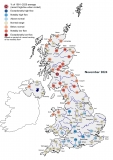Submitted by Michael Eastman on
Although unsettled for much of the first fortnight, and with a wintry tail, March saw a sustained spell of high pressure bringing widespread dry and unseasonably warm weather. With above average monthly temperatures, like each of the previous five months, it concluded the joint fourth warmest winter half-year (October – March) in the long Central England temperature series (from 1659). The warm temperatures were accompanied by low rainfall (59% of the March average for the UK as a whole), with the greatest deficits in Scotland. River flows were either in the normal range or below. Reservoir stocks fell in the north and west, most notably in western Scotland (Daer) and Yorkshire (Bradford Supply), but remained close to average at the national scale. During the warm, dry spell, soil moisture deficits (SMDs) developed across large parts of the UK. Groundwater levels rose during March at the majority of index sites across the different aquifers, except in the rapidly responding Carboniferous Limestone where they fell. At month-end, groundwater levels were generally in the normal range or below normal. Significant spring rainfall is needed for the recovery of river flows and depleted water resources in the north and west, and to sustain the recharge season particularly in the Carboniferous Limestone and in the Chalk of south-east England, allowing recovery of below-average groundwater levels.



